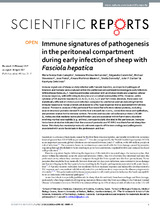Immune signatures of pathogenesis in the peritoneal compartment during early infection of sheep with Fasciola hepatica
Autor
Ruiz-Campillo, María Teresa
Molina Hernández, Verónica
Escamilla, Alejandro
Stevenson, Michael
Pérez, José
Martínez-Moreno, Álvaro
Donnelly, Sheila
Dalton, John P.
Cwiklinski, Krystyna
Editor
NatureFecha
2017Materia
Fasciola hepaticaSheep
Fasciolosis
METS:
Mostrar el registro METSPREMIS:
Mostrar el registro PREMISMetadatos
Mostrar el registro completo del ítemResumen
Immune signatures of sheep acutely-infected with Fasciola hepatica, an important pathogen of
livestock and humans were analysed within the peritoneal compartment to investigate early infection.
Within the peritoneum, F. hepatica antibodies coincided with an intense innate and adaptive cellular
immune response, with infiltrating leukocytes and a marked eosinophilia (49%). However, while
cytokine qPCR analysis revealed IL-10, IL-12, IL-13, IL-23 and TGFβ were elevated, these were not
statistically different at 18 days post-infection compared to uninfected animals indicating that the
immune response is muted and not yet skewed to a Th2 type response that is associated with chronic
disease. Proteomic analysis of the peritoneal fluid identified infection-related proteins, including
several structural proteins derived from the liver extracellular matrix, connective tissue and epithelium,
and proteins related to the immune system. Periostin and vascular cell adhesion protein 1 (VCAM-
1), molecules that mediate leukocyte infiltration and are associated with inflammatory disorders
involving marked eosinophilia (e.g. asthma), were particularly elevated in the peritoneum. Immunohistochemical
studies indicated that the source of periostin and VCAM-1 was the inflamed sheep liver
tissue. This study has revealed previously unknown aspects of the immunology and pathogenesis
associated with acute fascioliasis in the peritoneum and liver.

